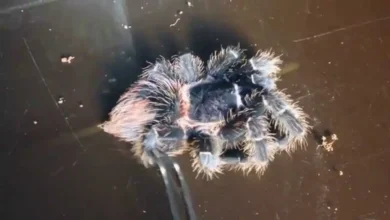Diseases and Treatments in Tarantulas: Common Pathologies and How to Act
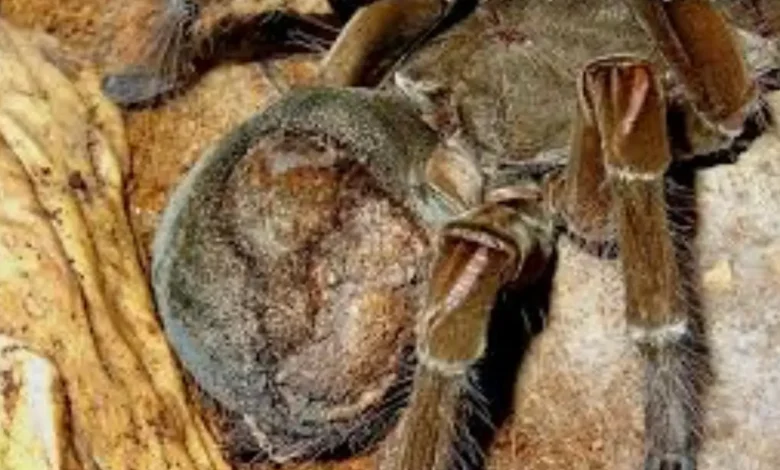
For years, it was believed that tarantulas were free from diseases. However, as interest in keeping these arachnids has grown, so has our understanding of the health challenges they face. This article delves into the most common illnesses affecting tarantulas, offering detailed guidance on recognizing symptoms, acting effectively, and preventing recurrence.
Mites: The Silent Enemy
Mites are tiny, light-colored arachnids that thrive in humid and poorly ventilated environments. While they often feed on organic debris, such as leftover food or decaying plants, a severe infestation can harm tarantulas, particularly those stressed, weakened, or kept in unsuitable conditions.
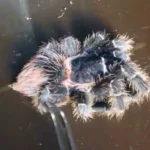 Dyskinetic Syndrome (DS) in Tarantulas: Causes, Symptoms, and Management
Dyskinetic Syndrome (DS) in Tarantulas: Causes, Symptoms, and Management
Symptoms of a Mite Infestation
- Visible signs: White specks on the chelicerae or other body parts.
- Behavioral changes: Lethargy or reduced activity.
- Feeding issues: Refusal to eat due to irritation from mites.
Action Plan for Mites
Mild Infestation
- Step 1: Isolation
Place the tarantula in a sterile container with dry paper towels or low-moisture substrate. - Step 2: Ventilation
Improve airflow in the terrarium to discourage mite growth. - Step 3: Spot Cleaning
Use a cotton swab dipped in diluted alcohol to gently remove mites from affected areas. Avoid overusing alcohol, as it can harm the tarantula’s delicate tissues. - Step 4: Clean the Habitat
Thoroughly sterilize the terrarium. Replace all substrate and clean all decorations with boiling water or a reptile-safe disinfectant.
Severe Infestation
- Step 1: Anesthesia
- Place the tarantula in a refrigerator for 15–25 minutes to slow its movements. Alternatively, use a CO2 chamber if available.
- Step 2: Manual Removal
- Use a cotton swab soaked in alcohol or iodine to remove mites from sensitive areas.
- Pay special attention to the chelicerae and joints.
- Step 3: Post-Treatment Care
- Return the tarantula to a clean, dry enclosure. Monitor closely for any signs of reinfestation.
Preventive Measures
- Regularly clean the terrarium and remove organic debris.
- Avoid over-humidifying the enclosure.
- Quarantine new tarantulas to ensure they are mite-free before introducing them to your collection.
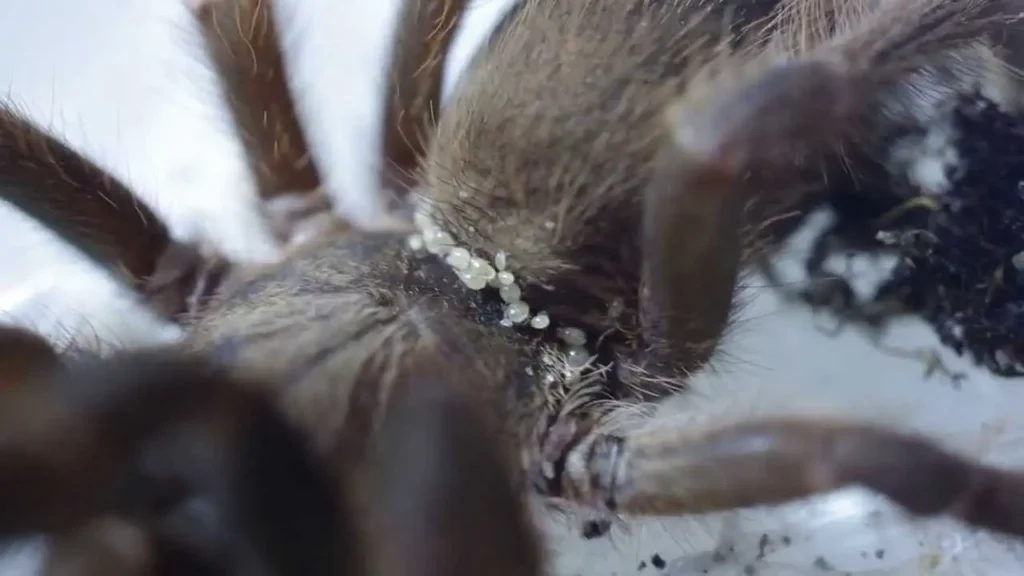
Visible mites clustered around the chelicerae of a tarantula.
Nematodes: A Serious Threat
Description
Nematodes are roundworm parasites that invade a tarantula’s mouth and respiratory system. These parasites are highly contagious and can spread through contaminated food or direct contact with infected animals.
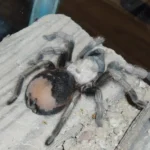 Fungal Infections, Mites, and Hair Loss in Tarantulas
Fungal Infections, Mites, and Hair Loss in Tarantulas
Symptoms of Nematode Infection
- Behavioral changes: Excessive nervousness or restlessness.
- Oral discharge: White or clear liquid dripping from the mouth.
- Feeding issues: Persistent refusal to eat.
- Unusual posture: Pedipalps held awkwardly beneath the chelicerae.
- Odor: A sweet or fermenting smell from the terrarium.
Action Plan for Nematodes
Early Detection
- Step 1: Isolate the infected tarantula in a sterile container. Use moistened paper towels to maintain a safe environment.
- Step 2: Clean and sterilize the terrarium, including all decorations and tools. Use boiling water for natural items like bark and logs.
- Step 3: Prevent cross-contamination by using separate tools for the infected tarantula.
Advanced Infection
- Step 1: Immobilization
- Use the refrigeration method or a CO2 chamber to safely anesthetize the tarantula.
- Step 2: Cleaning Process
- Prepare two containers: one with saline or lightly salted water, and another with clean water.
- Use a syringe to flush the mouth and chelicerae with saline solution. Remove all visible nematodes using a sterile cotton swab.
- Step 3: Medication (Optional)
- Administer low doses of Lamisol (used for parasitic infections in horses) or tetracycline to inhibit nematode reproduction. Consult with a vet specializing in exotic animals.
Post-Treatment Care
- Monitor the tarantula for signs of recovery, such as eating and webbing. If nematodes persist, repeat the cleaning process promptly.
Preventive Measures
- Avoid wild-caught specimens that might carry parasites.
- Quarantine all new arrivals for at least 1–3 months in a separate room.
- Ensure feeder insects (e.g., crickets) come from reputable sources.
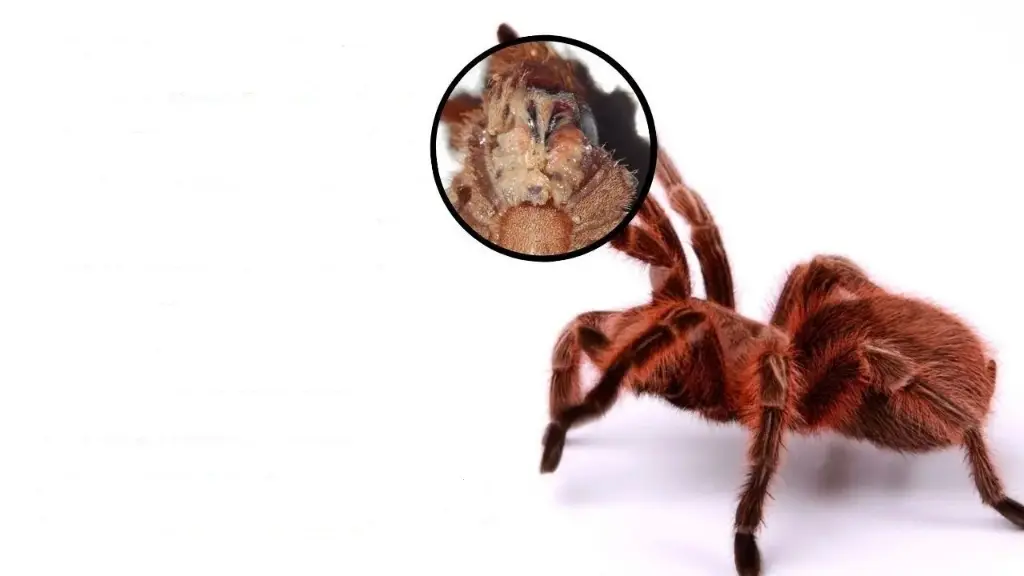
Nematodes visible around the chelicerae of a tarantula.
Tarantulas, like any living creatures, are susceptible to diseases. Identifying issues early and taking prompt action can save your tarantula’s life. Proper hygiene, quarantine practices, and careful observation are key to keeping your arachnid collection healthy.
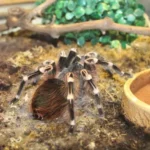 Cómo Preparar un Terrario para tu Tarántula
Cómo Preparar un Terrario para tu Tarántula
If you’re uncertain about treatment or notice persistent symptoms, consult a veterinarian who specializes in exotic pets for professional advice.

